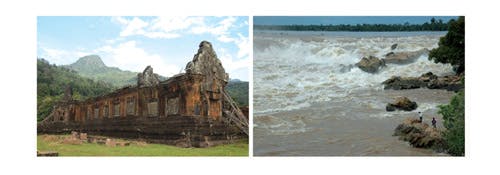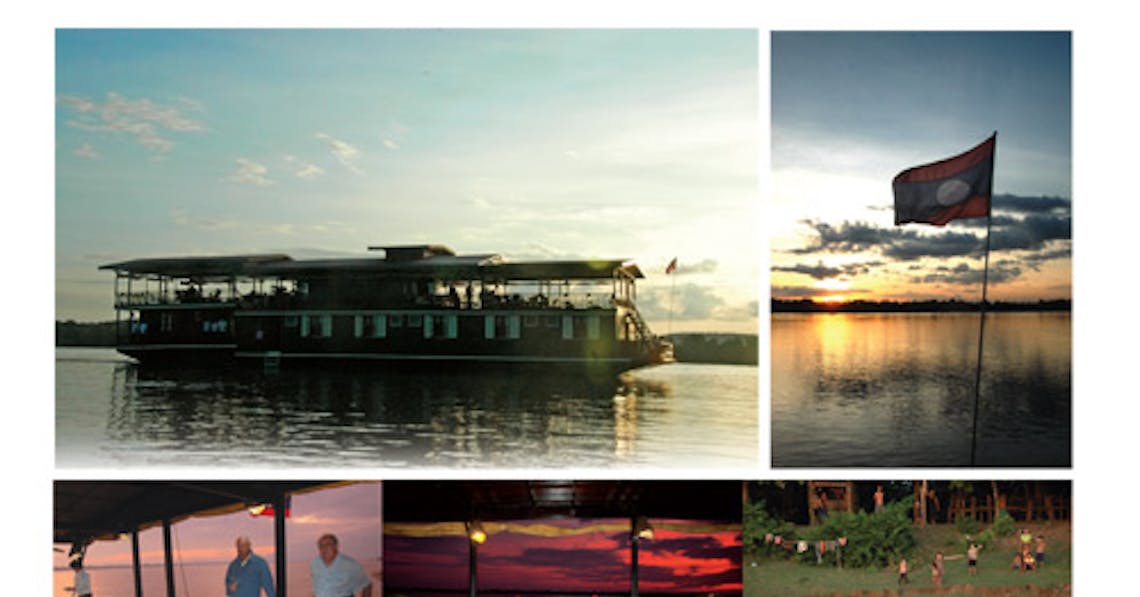Even knowing that nearly half the world’s population lives downstream of the Tibetan Plateau – Ganges, Irrawaddy, Salween, Yangtze, Indus and many more – the Mekong River is impressive. As it meanders its way down from Tibet, through China, Burma, Thailand, Laos, Cambodia and eventually lazing its way through Vietnam’s vast delta, spilling its muddy contents into the South China Sea, it provides lifeblood to millions. According to the World Wildlife Fund, ‘Its vivid tapestry of wildlife and plants, the wealth of fish swimming in its waters, and abundance of endemic and rare animals roaming its forests are rivaled only by the Amazon, which is six times larger in size.’ Home to two of the most critically endangered species in the world, the Irrawaddy Dolphin and the world’s largest fresh water fish, the Giant Catfish, the Mekong River not only has ecological and economical significance, but this mighty, majestic and meandering river has created, impacted, and witnessed history, as well as being an integral part of the cultural fabric of the region it forges its way through. All that aside though, it is simply a breathtakingly vast and beautiful river.
So it was with great excitement that our group (my parents and two friends) boarded the first of a succession of tiny propeller planes that would wobble us through the air to Pakse in Southern Laos, the starting point for our Mekong cruise. Pakse is a small city, lacking the charm of some of Laos’s more northern cities and towns, but with a number of decent hotels, a few casual restaurants and not much else going on. It is, however, the gateway to many of Southern Laos’s emerging attractions.

After a quiet night in Pakse, we meet at the Sinouk Coffee House for pain au chocolat and freshly brewed coffee straight from the neighbouring Bolaven Plateau, and set off on a two hour drive to the southern border with Cambodia. The first stop was a brief photo op at the Khone Falls, the main reason why the Mekong is not navigable into China – a discovery the French learnt to their great cost in the 19th century. A roaring waterfall, part of a series of falls stretching a mind boggling 10 kilometres wide, can be admired in all its glory from a viewpoint: gushing, raging, swirling, spraying and forcing its way towards the sea hundreds of kilometres away. We then boarded a comfortably and canopied long tail boat for a lazy tour of the Four Thousand Islands, some as large as small cities, other the size of a car, as they are moment-by-moment carved and shifted by the river’s unrelenting force. A brief stop at the charming backpacking Don Khon Village to visit an old French locomotive, a sad relic of the French’s painful effort to circumnavigate the Mekong’s rapids and falls by rail, a stop off at a school where our tears welled up to a sweet rendition of ‘Frère Jacques’ by the kindergarten class, and we were back on the boat, a refreshing bottle of Beer Laos in hand.
As we rounded a river bend, waving at children chasing us down the banks, we caught a glimpse of our home for the next two days. Originally a ferry carrying teak between Vientiane and Southern Laos, the boat was converted in 1993 into a luxury hotel on water: Beautiful ensuite private cabins a deux, two massive open-air decks to the fore and aft replete with daybeds, sofas, cushions, a dining room seating 20, a full bar, all polished up to the nines, and an attentive staff of 15. We sipped our welcome drinks, while being bathed in the spectacular deep salmon sunset. And as the pall of dusk fell, the only lights as far as the eye could see came from our boat, the moon and the stars.
The next morning, the boat berthed, we took a stroll down a small village, chatting with villagers, and handing out pencils, trakaw balls and knickknacks to scruffy and grinning children. The rest of the day was spent sitting on the breezy deck, the crisp chill of approaching winter in the air, watching the banks go by…the constant chirps and chimes of children carrying and echoing across the river, as they hung from trees, skidded down the banks, waded into the water and cheerfully chased and waved at us. There was nothing much to see; yet we experienced more than we expected. The occasional fisherman casting his lure from a tiny tottering boat, every few hours a glimpse of a motorcycle or concrete house, the few signs of the 21st – let alone 20th – century, and all around the vast waters of the Mekong and its river edge swarming with children. We were fed like kings, drank fine French wine, chatted to our three fellow passengers, read books, and waved some more.
It was delightful.
Our last day dawned…too soon. A short walk through the jungle took us on a morning visit to the 9th century Oum Muong ruins. Eerie and quiet, we were the only visitors so early in the day; large thick-canopied raintrees sheltered and shadowed the Khmer ruins beneath. After a leisurely breakfast on the boat, we visited the cruise highlight, the Vat Phou ruins, which similarly predates Angkor. Set at the base of a distinctive mountain peak – thought to resemble the Hindu lingam – this temple is typical Khmer with its sophisticated irrigation system, man-made lakes, and its layers of ascent up the mountain. Its ancient steps are haphazardly – and hazardously – reassembled, but well worth the climb as we scaled our way towards the sacred sanctum of the ancients, finally stopping to take in the sweeping views of the plains below.
From Vat Phou, it was a mere 40 minutes’ drive to the relative norm of Pakse. After a celebratory dinner at Hotel Pakse’s French Le Paronama restaurant, a few toasts and a fond farewell to our new friends, it was time to get some rest before our return journey to Chiang Mai.
The Mekong Vat Phou Cruise is truly a unique and very special experience. The staff on the boat cater to your every beck and call, a private tour guide is assigned to each party, the Thai-Lao food is sumptuous and the boat itself more than luxurious. Being on a boat, naturally, does not allow you to fully explore Southern Laos as one would by bus or other more earthy means, however, without the luxury of time, our three days’ cruise was truly memorable. After all, the highlight and the raison d’être, is the river itself: the Mekong in all its glory.
www.vatphou.com – for all information on this cruise.
Recommended hotel: Hotel Pakse (starting at 750 baht a night)
Flights from Bangkok: Lao Airways (Bangkok-Savannakhet for a 20 minute stop-Pakse)
